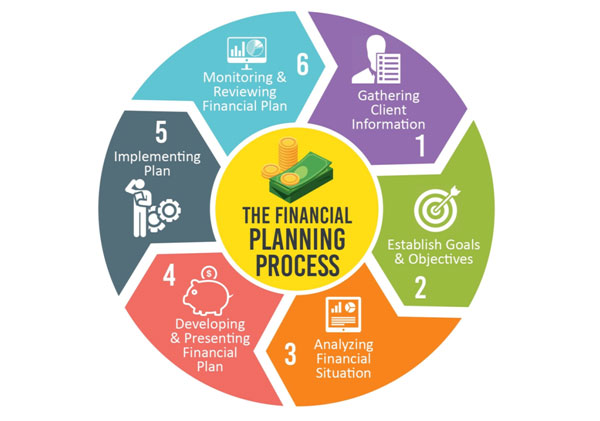Financial planning is an end to end life cycle of wealth management by an individual or an organization. It comprises of various steps that will encompass entire lifecycle. It starts with Goal setting and helps develop an action plan for achieving the goals.
A plan that follows a well-defined, documented process, implemented and most importantly regular monitoring process has the best potential of being successful and achieve all your goals. No plan can guarantee financial security or wealth creation but a well implemented one will provide best opportunity to achieve both.

Step 1 – Gathering financial and personal information
Any process is as successful as the data driving it is, the first step of financial planning process is to collect data about the financial health of the individual. It is critical that the quality of data is accurate, complete and the financial planner has clarity on the same. The data collected should at the least include:
This will be foundation of your Financial Plan
Step 2–Establishing and agreeing your goals
The second step is to write down your goals, these can be short term like buying a car or long term such as retirement. You can also include things on your bucket list and what you wish to do if you get some extra money. The purpose of this analysis is to differentiate your needs from your wants.
This will be the guide on what your Financial plan and roadmap for your financial future.
The goals show always be SMART:
In this step your financial adviser will analyze the data you provided in step 1 and 2and uses it to produce a report that reflects your current and future financial profile.
S/he will calculate the key ratios like savings, liquidity. It should include your Net Worth and cash flow statement.
This exercise will let you know how well you are doing with your Financial Life. You will also know your risk profile and tolerance.
This report should be reviewed with your advisor and risk tolerance agreed
In this step the advisor will develop a financial plan. This should cover the goals as set in step 2, how you can achieve those, risk and opportunities you have.
This report includes end to end Financial needs, protection of your assets with insurance, Emergency funds for unseen life situation and investment details for meeting the goals
Ideally an advisor should develop alternatives which will help in making the right decision and choice. You need to evaluate possible courses of action, taking into consideration each
individual personal value, life stage, Job condition and what they will like to achieve. You should also evaluate risk and lost opportunities that will result from your decisions.
The report is presented, explained, discussed and agreed between client and adviser.
In this step of the financial planning process, the advisor or you will implement the plan. To implement your financial action plan, you should look at and buy / invest in the instruments as agreed in Step 4.
This may require help of third parties to execute like insurance broker or buy stocks through PMS service.
Financial planning is a dynamic on-going process that requires continuous monitoring. Review of the actions recommended in the plan should take place regularly, and the goals should be reviewed annually to take account of a change in income, asset values, business or family circumstances.
As nothing is permanent in life so is the financial plan, you need to track the investments to see if they are still relevant and best suited for you. New products might come in the market that may be better suited for meeting your goals.
Changing personal, social and economic factors will also impact your financial plan. We recommend a Quarterly review of your investment and a detailed review every year.
You should also periodically revisit your financial goals. This involves reviewing what has been achieved and if you need to add or delete any of the previous goals. Ideally this exercise should be done on any major life changes like addition in family or once in 3 years.
We all need to achieve our financial planning goals in a structured manner to get the best results.